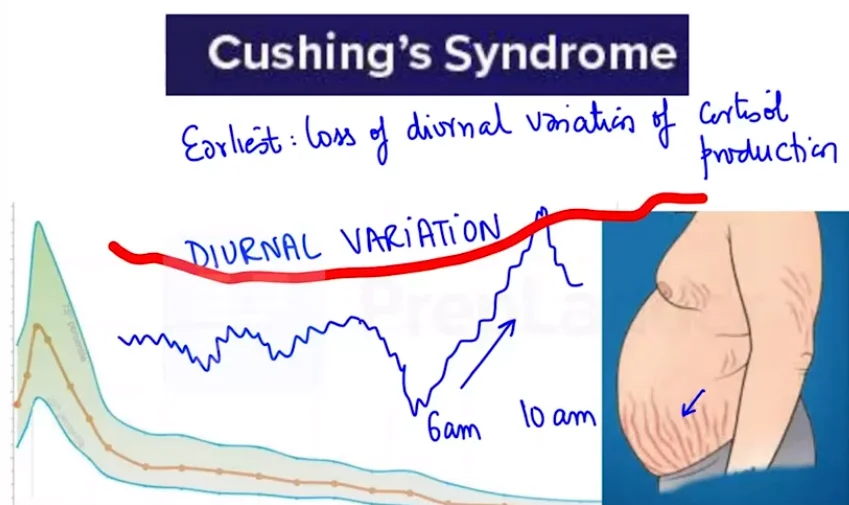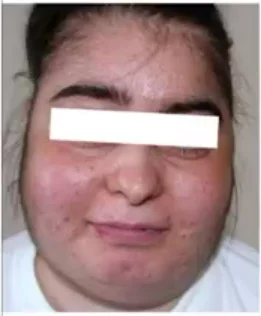Cushing Syndrome: Causes, Clinical Features and Diagnosis
May 31, 2023
Navigate Quickly
Introduction to Cushing Syndrome
Causes of Cushing Syndrome
Clinical Features of Cushing Syndrome
Diagnosis of Cushing Syndrome
Treatment of Cushing Syndrome
Nelson Syndrome

When cortisol levels in the body are excessive for an extended period of time, Cushing syndrome develops. This can happen when the body produces too much cortisol or if you take drugs called glucocorticoids, which have a similar effect on the body to cortisol.
Some of the prominent signs of Cushing syndrome, such as a fatty hump between the shoulders, a round face, and pink or purple stretch marks on the skin, can be brought on by excessive cortisol. High blood pressure or bone loss can also be a result of Cushing syndrome. It can occasionally lead to type 2 diabetes.
Reduced cortisol levels and symptom improvement are possible with treatments for Cushing Syndrome. The likelihood of recovery is improved the earlier treatment is initiated.

Introduction to Cushing Syndrome

Cortisol is a steroid hormone that is frequently referred to as the "stress hormone." When you are stressed, your body produces more cortisol. Cortisol is necessary for :
- Keeping blood pressure constant.
- Control of blood sugar.
- Inflammation reduction.
- Making new memories.
- Controlling breathing.
- Salt balance in your body.
- Converting the energy in your diet.
Cortisol levels are regulated by the pituitary gland, located in the brain, the hypothalamus, a region of the brain above the pituitary gland, and the adrenal glands, two tiny glands located on top of the kidneys.
Cortisol is highest in early morning as it is a stress hormone so during early morning as people are proceeding to perform their daily activities the cortisol levels increases. 75% of daily cortisol is produced in morning hours.
Earliest presentation is loss of diurnal variation. The cortisol levels are different during the day and this variation is known as diurnal variation. In cushing syndrome this variation is lost.
Also Read: Pectus Excavatum: Causes, Symptoms, Risk Factors, Diagnosis and Treatment
Causes of Cushing Syndrome
- Iatrogenic steroids (exogenous) are the most common cause of cushing syndrome. This the levels of cortisol are raised whereas the ACTH levels are decreased by feedback mechanism
- Ectopic production of ACTH - Carcinoid tumor, Oat cell CA lung
Ectopic ACTH production leads to increased Cortisol levels. ACTH acts as partial melanocyte stimulating hormone like action thus leads to hyperpigmentation on creases of skin (palms and soles)
- Pituitary Adenoma, Aka Cushing’s disease- In this there is increased ACTH production thus leading to increased Cortisol (Endogenous cause).
Also Read: Infectious Mononucleosis: Causes, Symptoms, Diagnosis, Treatment, Prevention and Complications

Clinical Features of Cushing Syndrome
- Moon facies
- Centripetal Obesity (lemon on stick appearance)
- Easy bruisability
- Proximal myopathy
- Violet/ purple Striae, Thin skin, Purpura
- Weight gain
- Increased Peripheral resistance → HTN


- Insulin resistance increase the blood sugar levels as well as cortisol also increases the blood sugar levels so in this condition we can find:
- FBS > 126 mg%
- 2hr > 200 mg%
- Secondary DM
- Treatment: Metformin and not insulin as insulin will result in further weight gain of the patient.
- Increases Cortisol Activates ENaC (epithelial sodium channel) which Causes salt & water retention and increased Urinary loss of potassium and hydrogen thus leading to Hypokalemic alkalosis.

- Increased cortisol levels Activates Sex steroid receptors thus causing Hirsutism, weight gain, oligomenorrhea, infertility in women
- Hyperpigmentation will be present in ectopic ACTH and Cushing disease/Exogenous cause.
Also Read: Gastroparesis: Causes, Symptoms, Risk Factors, Diagnosis, Treatment and Complications
Diagnosis of Cushing Syndrome
- Screening test
- 24-hour urinary cortisol levels are checked. We will find a increase in cortisol levels.
- Spot Salivary Cortisol Levels- in this cortisol levels will also be increased
- Overnight dexamethasone suppression test
- Investigation of choice
- Low dose dexamethasone suppression test 0.5 mg 6 hourly for 2 days
- Imaging:
- MRI Head is done in case of pituitary adenoma which is also known as ACTH dependent Cushing syndrome because in this the cortisol levels are increased in response to increased ACTH levels.
- CT Abdomen is done in case of Adrenal adenoma which is also known as ACTH independent cushing syndrome because in this the cortisol levels are increased independent of ACTH levels as the problem is in zona fasciculata which is responsible for increased cortisol levels;
- ACTH levels (↑ / ↓)
Also Read: Urinary Bladder Cancer: Causes, Symptoms, Types, Risk Factors, Diagnosis, Treatment and Prevention
Treatment of Cushing Syndrome
- Taper Steroids- As in patients taking steroids we can't stop the steroids immediately so we will slowly try to reduce the dosage. And in immunocompromised patients we will start alternate steroid sparing agents like azathioprine.
- Oat cell lung cancer
- Chemotherapy with Cisplatin + Irinotecan
- Pituitary adenoma/Cushing disease
- Trans-sphenoidal Surgery
- Adrenal adenoma- Prior to surgery we are giving certain drugs which are also known as Medical Adrenalectomy. It includes:
- Metyrapone
- Aminoglutethimide
- Mitotane
- Oral Ketoconazole
Nelson Syndrome
It is caused due to bilateral Adrenalectomy which is performed to treat bilateral adrenal adenoma producing a mass effect. During surgery to prevent addisonian crisis IV Hydrocortisone drip can be given to the patient and post op to maintain the cortisol levels in the body life-long hydrocortisone supplementation is added. Due to static levels of steroids, no feed-back inhibition on ACTH is present so the ACTH will be increased thus resulting in Hyperpigmentation on creases of palms and soles. Only Pulsatile release of cortisol can inhibit ACTH production.
Also Read: Leukemia: Causes, Symptoms, Classification, Types, Risk Factors, Diagnosis and Treatment
Download the PrepLadder app now to access high-yield content with 24-hr Free Trial. Explore premium study resources like Video Lectures, digital notes, QBank, and Mock Tests for a seamless exam preparation. Time to begin your NEET PG preparation courses online with PrepLadder.

PrepLadder Medical
Get access to all the essential resources required to ace your medical exam Preparation. Stay updated with the latest news and developments in the medical exam, improve your Medical Exam preparation, and turn your dreams into a reality!
Top searching words
The most popular search terms used by aspirants
- NEET PG Medicine
- NEET PG Medicine Preparation
PrepLadder Version X for NEET PG
Avail 24-Hr Free Trial